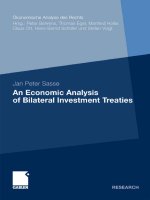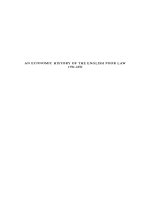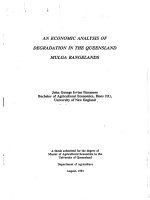an economic analysis of financial structure
Bạn đang xem bản rút gọn của tài liệu. Xem và tải ngay bản đầy đủ của tài liệu tại đây (244.33 KB, 21 trang )
Copyright 2011
Pearson Canada Inc.
8 -
1
Chapter 8
An Economic Analysis of
Financial Structure
Copyright 2011
Pearson Canada Inc.
8 -
2
Eight Basic Facts About Financial Structure I
1. Stocks are not the most important sources of
external financing for businesses.
Copyright 2011
Pearson Canada Inc.
8 -
3
Eight Basic Facts About Financial Structure II
2. Issuing marketable debt and equity securities is not
the primary way in which businesses finance their
operations.
3. Indirect finance is many times more important than
direct finance.
4. Financial intermediaries are the most important
source of external funds.
Copyright 2011
Pearson Canada Inc.
8 -
4
Eight Basic Facts About Financial Structure III
5. The financial system is among the most heavily
regulated sectors of the economy.
6. Only large, well-established corporations have easy
access to securities markets to finance their activities.
7. Collateral is a prevalent feature of debt contracts.
8. Debt contracts are extremely complicated legal
documents that place substantial restrictive covenants
on borrowers.
Copyright 2011
Pearson Canada Inc.
8 -
5
Transaction Costs
•
Transaction costs are a major problem in
financial markets.
–
e.g. brokerage fees
•
Financial intermediaries have evolved to
reduce transaction costs
–
Economies of scale
–
Expertise
Copyright 2011
Pearson Canada Inc.
8 -
6
Asymmetric Information
Asymmetric Information: one party has insufficient
knowledge about the other party involved in a
transaction.
Two types of asymmetric information.
1. Adverse selection occurs before the transaction
2. Moral hazard arises after the transaction
•
Agency theory analyses how
asymmetric information problems affect economic
behavior
Copyright 2011
Pearson Canada Inc.
8 -
7
Adverse Selection: The Lemons Problem
•
George Akerlof, The Market for Lemons, QJE (1970)
•
If quality cannot be assessed, the buyer is willing to
pay at most a price that reflects the average quality.
•
Sellers of good quality items will not want to sell at
the price for average quality.
•
The buyer will decide not to buy at all because all
that is left in the market is poor quality items.
Copyright 2011
Pearson Canada Inc.
8 -
8
Tools to Solve Adverse Selection Problems
•
Private production and sale of information
–
Free-rider problem
•
Government regulation to increase information
•
e.g. firms selling securities are required to have independent audits.
•
Financial intermediation
–
Experts in producing information, can determine good
risks from bad ones, no issue with free riding.
•
Collateral and net worth (equity capital)
Copyright 2011
Pearson Canada Inc.
8 -
9
Moral Hazard : The Principal – Agent Problem
•
Moral hazard is the asymmetric information
problem that occurs after the transaction has
occurred.
–
e.g. seller of security may have incentives to hid
information and engage in undesirable activities
•
Separation of ownership and control
of the firm
–
Managers pursue personal benefits and power
rather than the profitability of the firm.
Copyright 2011
Pearson Canada Inc.
8 -
10
Tools to Solve the Principal-Agent Problem
•
Monitoring (Costly State Verification)
–
Free-rider problem
•
Government regulation to increase information
–
e.g. criminal penalties for hiding or stealing profits.
•
Financial Intermediation
–
e.g. venture capital firms
•
Debt Contracts have smaller moral hazard issues
Copyright 2011
Pearson Canada Inc.
8 -
11
Tools to Solve Moral Hazard Problem: Debt Markets
•
Net worth and collateral
–
Incentive compatible
•
Monitoring and Enforcement of Restrictive
Covenants
–
Discourage undesirable behavior
–
Encourage desirable behavior
–
Keep collateral valuable
–
Provide information
•
Financial Intermediation
Copyright 2011
Pearson Canada Inc.
8 -
12
Asymmetric Information
Copyright 2011
Pearson Canada Inc.
8 -
13
Conflicts of Interest
•
Conflicts of Interest is a type of moral hazard problem
caused by economies of scope.
•
Arise when an institution has multiple objectives and, as
a result, has conflicts between those objectives.
•
A reduction in the quality of information in financial
markets increases asymmetric information problems.
•
Financial markets do not channel funds into productive
investment opportunities.
•
The economy is not as efficient as it could be.
Copyright 2011
Pearson Canada Inc.
8 -
14
Why Do Conflicts of Interest Arise? I
•
Underwriting & Research in Investment Banking
–
Information produced by researching companies is
used to underwrite the securities. The bank is
attempting to simultaneously serve two client
groups whose information needs differ.
–
Spinning occurs when an investment bank
allocates hot, but underpriced, IPOs to executives
of other companies in return for their companies’
future business.
Copyright 2011
Pearson Canada Inc.
8 -
15
Why Do Conflicts of Interest Arise? II
•
Auditing and Consulting in Accounting Firms
–
Auditors may be willing to skew their judgments
and opinions to win consulting business.
–
Auditors may be auditing information systems or
tax and financial plans put in place by their
nonaudit counterparts.
–
Auditors may provide an overly favorable audit to
solicit or retain audit business.
Copyright 2011
Pearson Canada Inc.
8 -
16
Credit Assessment & Consulting in Credit Rating
Agencies
•
Investors use credit ratings to reflect probability of
default.
•
Used to determine creditworthiness
•
Conflict of interest occurs when multiple users with
divergent (short-term) interests depend on the credit
rating
•
Conflicts arise when credit rating agencies undertake
consulting services
–
Firms ask credit rating agencies how to structure debt
–
Agencies may provide good ratings to attract new clients.
Copyright 2011
Pearson Canada Inc.
8 -
17
Conflicts of Interest: Remedies I
•
Sarbanes-Oxley Act of 2002 (Public Accounting
Return and Investor Protection Act)
–
Increases supervisory oversight to monitor and
prevent conflicts of interest.
–
Establishes a Public Company Accounting
Oversight Board.
–
Increases the SEC’s budget.
–
Makes it illegal for a registered public accounting
firm to provide any nonaudit service to a client
contemporaneously with an impermissible audit.
Copyright 2011
Pearson Canada Inc.
8 -
18
Conflicts of Interest: Remedies II
•
Sarbanes-Oxley Act of 2002 (cont’d)
–
Beefs up criminal charges for white-collar crime
and obstruction of official investigations.
–
Requires the CEO and CFO to certify
that financial statements and disclosures are
accurate.
–
Requires members of the audit committee to be
independent.
Copyright 2011
Pearson Canada Inc.
8 -
19
Conflicts of Interest: Remedies III
•
Global Legal Settlement of 2002
–
Requires investment banks to sever the link between
research and securities underwriting.
–
Bans spinning .
–
Imposes $1.4 billion in fines on accused
investment banks.
–
Requires investment banks to make their analysts’
recommendations public.
–
Over a 5-year period, investment banks are required
to contract with at least three independent research
firms that would provide research to their brokerage
customers.
Copyright 2011
Pearson Canada Inc.
8 -
20
Control Attestation in Canada I
•
In October 2002, the Ontario government introduced Bill
198 in response to reforms in the United States.
•
Similar to Sarbanes-Oxley Act
•
Bill made several reforms to security laws including:
–
CEO and CFO accountability for financial reporting;
–
auditor independence;
–
enhanced penalties for illegal activities, and
–
faster public disclosure.
Copyright 2011
Pearson Canada Inc.
8 -
21
Control Attestation in Canada II
•
In February 2005, the Canadian Securities
Administrators proposed the Internal Control Instrument
and the Certification Instrument.
•
These mirror the requirements of the Sarbanes-Oxley
Act in the United States .









